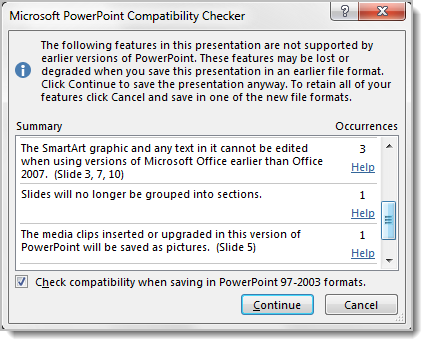Converter Powerpoint 2010 To 2007 Downloadmarcus Reid
- Converter Powerpoint 2010 To 2007 Downloadmarcus Reidsville
- Converter Powerpoint 2010 To 2007 Downloadmarcus Reid X


When you open a PowerPoint presentation made in an earlier version of PowerPoint, the program switches to compatibility mode. PowerPoint 2007 shuts down features that weren’t a part of earlier versions of PowerPoint to accommodate the presentation. You can tell when PowerPoint is in compatibility mode because the words compatibility mode appear in the title. Device / Program: pptx: Category: Document File: Description: As part of Microsoft's 2007 suite another open XML document type was introduced. This time in the PowerPoint sphere, PPTX is a Presentation.
Converter Powerpoint 2010 To 2007 Downloadmarcus Reidsville

A powerful and easy-to-use add-in for showing the classic menus and toolbars of PowerPoint 2003 on Ribbon of PowerPoint2007. Supports all languages that are supported by PowerPoint2007 including: English,French,German,Japanese and more.
- powerpoint-classic-menu.exe
- ACCM Software
- Shareware ($14.95)
- 636 Kb
- WinNT 3.x, WinNT 4.x, Windows2000, WinXP, Windows2003, Windows Vista
Show Classic Menus and Toolbars on the Ribbon of Microsoft PowerPoint2007. Supports all languages that are supported by Microsoft PowerPoint2007.
- Setup_PowerPointMenu.exe
- Addintools
- Shareware ($15.99)
- 3.27 Mb
- WinXP, WinVista, WinVista x64, Win7 x32, Win7 x64, WinOther, WinServer
Add the old PowerPoint 2003 menu layout to PowerPoint 2007. PowerPoint 2007 required..
- setup.exe
- Sobolsoft
- Shareware ($19.99)
- 308 Kb
- Win98, WinME, WinXP, Windows2000, Windows2003
Classic Style Menus and Toolbars for Microsoft PowerPoint2007 4.1 gives you a simple yet useful add-in to help with showing the classic menus and toolbars of PowerPoint 2003 on ribbon of PowerPoint2007. All of the new features in PowerPoint2007. ...
- Classic Style Menus andToolbars for MicrosoftPowerPoint 2007
- ACCM Software
- Trial ($11.96)
- 570 Kb
- Windows Server 2003, Windows Vista, Windows S
Classic Style Menus and Toolbars for PowerPoint2007 4.1.1 gives you a functional and helpful add-in for showing the classic menus and toolbars of Microsoft PowerPoint 2003 on Ribbon of Microsoft PowerPoint. ...
- powerpoint-classic-menu-trial.zip
- ACCM Software
- Trial ($14.95)
- 533 Kb
- Windows 2K , XP , 2003 , Vista , 2008 , 7
Express Gliederung is an add-in to create breakdowns or content directories to a Microsoft PowerPoint Presentation on the easiest way.So far, only Microsoft PowerPoint2007 will be supportet.
- Express Gliederung forPowerPoint 2007
- Nils Rathjen
- Freeware (Free)
- Windows
Create attention-grabbing slides quickly, collaborate with team members on your presentations, and share them live or Create attention-grabbing slides quickly, collaborate with team members on your presentations, and share them live or online..
- Microsoft Office PowerPoint2007 SP1
- 5am Code
- Commercial ($)
- Windows Vista, Windows XP SP 2, Windows 2003
PowerFlashPoint is a PowerPoint plug-in that automatically converts your PowerPoint2007, XP/2002 & 2003 presentations into a highly compressed Internet-ready presentation in the Macromedia Flash format. Easily distribute your presentations via. ...
- Convert-Powerpoint-to-Flash-2.5Free-download.exe
- PowerFlashPoint
- Shareware ($199.00)
- 7.2 Mb
- Win XP, 2003, 2000, Vista
Free corrupt Word 2007 DOCX, Excel 2007 XLSX, PowerPoint2007 PPTX, Open Office Writer, Open Office Calc & Open Office Impress data/text salvage service. Upload your corrupt Office 2007 or Open Office file and get back the original data or text so it. ...
- Corrupt Office 2007-OO TextExtractor
- S2 Services
- Freeware (Free)
- 10 Kb
- WinXP, Windows2000, Windows2003, Windows Tablet PC Edition 2005, Windows Media Center Edition 2005, Windows Vista, Unix, Linux, Linux Gnome, Linux GPL, Linux Open, OS, 2, OS, 2 Warp, OS, 2 Warp 4, Mac OS X 10.2, Mac OS X 10.3, Mac OS X 10.4, Mac OS X 10.5, BEOS
Pass MCAS exam 77-603 in first attempt. 361 questions with detailed explanation and 172 study notes. 77-603 - Using Microsoft Office PowerPoint2007 study notes, articles and mock test. 99% pass rate, 100% money back guarantee. Based on latest. ...
- M77-603.exe
- uCertify India
- Shareware ($1.44)
- 10 Kb
- Win98, WinME, WinNT 4.x, WinXP, Windows2000, Windows2003, Windows Media Cen
FlashPoint is help you create professional-look Flash video with PowerPoint knowledge.Supports MS Office PowerPoint2007.
- ppt2flashp.exe
- convert powerpoint to flash
- Shareware ($49.00)
- 2.87 Mb
- Win95, Win98, WinME, WinNT 4.x, Windows2000, WinXP, Windows2003, Windows Vista
A powerful and easy-to-use add-in for showing the classic menus and toolbars of Microsoft Office 2003 on Ribbon of Microsoft Office 2007. Supports all languages that are supported by Office 2007 including: English,French,German,Japanese and more.
- office-classic-menu-trial.zip
- ACCM Software
- Shareware ($24.95)
- 596 Kb
- WinNT 3.x, WinNT 4.x, WinXP, Windows2000, Windows2003, Windows Vista

Converter Powerpoint 2010 To 2007 Downloadmarcus Reid X
Abnormal Psychology | (From the publisher) “Rosenberg and Kosslyn's Abnormal Psychology brings students to the very forefront of the study of the brain and its role in psychological disorders. Now that text returns in a new edition that again matches the latest research from neuroscience to culture-based approaches with riveting human examples, helping your students understand the both the scientific foundations and the personal impact of mental illness. The new edition also brings forward the books distinctive emphasis on the dynamic interplay between the neurological, psychological, and social factors involved in understanding psychological disorders and their treatment.' The first edition was published in 2009, and in 2011 we published a briefer text, Essentials of Abnormal Psychology. |
Top Brain, Bottom Brain: |
Because this one is different. Top Brain, Bottom Brain offers a new, defensible theory of brain functioning and psychology, based on a major anatomical distinction that is frequently overlooked. The 'Theory of Cognitive Modes' that we present here is built on conclusions arising from decades of research that, for the most part, has remained inside scientific circles. A 'cognitive mode' is a general way of thinking that underlies how a person approaches the world and interacts with other people. ... In this book, we seek to return to the hypothesis-driven tradition by proposing a new, plausible, and coherent theory that is strongly rooted in empirical findings. ... We hope that the reader will take the ideas we present as well-founded hypotheses that are worth considering, not as received truth. We also hope this book will inspire a new round of studies that will further enrich our understanding of how the brain really works. More than that, we hope that our Theory of Cognitive Modes will be an important contribution to understanding ourselves, as humans and as individual people. The theory we offer here should prompt you to think about issues you probably did not previously consider. Whether your interest is to evolve personally, socially, or in business --or all three-- we believe that understanding and considering the Theory of Cognitive Modes can benefit you. |
Introducing Psychology: | Does the field of psychology really need another introductory psychology textbook? This is what Robin Rosenberg and I, as coauthors, asked each other as we started to consider writing the first edition of this book. One of us is a cognitive neuroscientist and the other a clinical psychologist. In working together, we began to see how our different areas of psychology were dovetailing. We had both come to view psychology in terms of events that occur at different levels of analysis: the brain (biological factors), the person (beliefs, desires, and feelings), the group (social, cultural, and environmental factors), and their interactions. This view of psychology is exciting because it can be applied to all psychological phenomena and can offer a way to organize a diverse range of theories and discoveries. We realized that this was an important way of teaching psychology. Different fields of psychology are interconnected, although they are not often presented this way in textbooks. Introducing Psychology: Brain, Person, Group is the fourth edition of this textbook. The first edition (Psychology: the Brain, the Person, the World) was published in 2001, a second edition in 2003, and a third edition (Psychology in Context) in 2006. We have also published three editions of a briefer text, the current edition of which is Fundamentals of Psychology in Context, published in 2006 by Allyn & Bacon (now part of Pearson). |
Better PowerPoint® |
This book distills the core of my earlier book into a quick guide on how to revise an existing presentation. I have also added new material, partly in response to feedback I received regarding the earlier book. This book is organized so that the reader can easily revise a presentation in a couple of hours, using simple checklists at the start of each chapter. |
Clear and to the Point | The happy confluence of two activities led to this book. First, while working on a revision of an earlier book about graph design, I noticed that the same psychological principles extend beyond graph design to all visual communication. Those principles of perception and cognition are at work no matter what we humans are doing, be it interpreting graphs, playing golf, reading tea leaves, or anything else (including giving PowerPoint presentations). Second, I was a member of many search committees in my department, which involved sitting through innumerable PowerPoint presentations that -- ironically (given that I'm in a department of psychology) -- violated psychological principles. The PowerPoint program is like the weather: Everybody likes to complain about it, but nobody does anything about it. This book is an attempt to clear the PowerPoint skies. People complain the most about the presentations PowerPoint allows users to produce, which can be irritating, confusing, boring, condescending, and incomprehensible. I doubt that creators of those presentations intend to come off in any of these ways, but they simply haven't had guidance in how to use this medium to be clear and to the point. This book's mission is to provide that guidance. |
Graph Design for the |
This book explores some applications that follow from cognitive neuroscience, particularly in the domains of perception and memory. The book presents a set of principles, based on empirical findings, for presenting information effectively in graphs. I not only make use of information about the number of elements that can be held in mind at once, the size labels must be in order to be read easily, and so forth, but also exploit implications of some relatively subtle effects arising from the range of spatial frequency channels in vision, the separation of the 'what' and 'where' visual pathways, and the like. The first edition, Elements of Graph Design, was published by W. H. Freeman & Co. in 1994, but when it went out of print in 2004, I decided to use it as the foundation for the present book, which differs from that one in five ways: The principles underlying my recommendations have been revised and reorganized; I have updated the review of research on graphic communication; I have integrated the relevant science of perception and cognition into the text (rather than relegating it to endnotes); I have corrected errors that were present in the earlier edition; and, finally, the book has been redesigned visually for easier reading. |
The Case for Mental Imagery | In this book I and my co-authors, William Thompson and Giorgio Ganis, make the case that mental images depict information and that these depictions play a functional role in human cognition. We have not only tried to summarize the conceptual grounds for positing this species of internal representations but also appealed to many and varied sorts of empirical discoveries. In addition, we have outlined a specific theory of how depictive representations are used in information processing and how they arise from neural processing. We have summarized this theory not to defend our specific formulation but rather to provide an existence proof that such a class of theory can be developed and supported. |
Cognitive Psychology: | The goal of this book is to help students master classic studies mixed with exciting new work, both of which illustrate key concepts in the field of cognitive psychology. This book has an unusual history. Early on, Edward Smith and I confronted the fact that we were not experts in all of the areas of the new cognitive psychology, and so decided to enlist the help of distinguished researchers in the different areas. However, we were also mindful of the need to write a book, not edit a collection of independent chapters. The contributors wrote a first draft (except for chapters 1 and 7, which were written by me and Ed, respectively). Ed and I revised and edited the chapters, and sent them to wordsmith Nancy Brooks, who edited, re-wrote, and asked for clarification--and thus began a detailed process of refining and revising the entire book. Thus the whole team must be thanked for the final product: Adriane Seiffert, Jeremy M. Wolfe, and Frank Tong (chap 2), Marlene Behrmann and Joy Geng (chap 3), Lawrence W. Barsalou (chap 4), Anthony D. Wagner (chap 5), Todd S. Braver (chap 6), Elizabeth Phelps (chap 8), Reid Hastie and Alan Sanfey (chap 9), Kevin Dunbar and Jonathan Fugelsang (chap 10), Jean Decety and Jessica Somerville (chap 11), Maryellen C. MacDonald (chap 12), Jayme Hefler, Susanna Lesan, Jessica Mosher (our editors), and especially Nancy Brooks, editor extraordinaire. |
Image and Brain | I had a broken leg in 1991-92 (a bad ice skating accident), and was in bed for months. So, I had a computer put at the bedside and used 32 point type so I could see what I was writing, and wrote most of two books that year. This one is the direct descendant of Image and Mind. It maps the key elements of the earlier theory into a theory about the operation of specific neural structures. In so doing, it draws additional distinctions that were not present in the earlier theory and provides evidence that imagery is an integral part of perception proper. And it leads to new sorts of predictions, which were (and are being) tested using various neuroimaging techniques. For years, in fits and starts, I've been writing another book on imagery to make the ideas in this one more accessible. One reviewer dwelt on the fact that the book is very (excessively, he clearly meant) detailed. But in my area of research, it's better to be condemned for being too detailed than to be dismissed for being too vague... |
Wet Mind |
The idea of mapping cognitive activity into the brain afforded all sorts of new ways to inform theory. I called this the 'Wet Mind' approach--taking advantage of the idea that 'the mind is what the brain does' to make use of what is known about the brain to understand the mind. To teach myself what was known about how the brain does cognition, I taught a course ('Minds, Brains, & Computers') for a few years. The lecture notes became the first five chapters of this book. Olivier Koenig helped me convert the bits and pieces of later lectures into the rest of the book. This book, first published in 1992, provides a 'big picture' of how cognitive activities of many sorts arise from the workings of the brain. We did an update in 1995, with an epilogue on emotion. This was just in time. With the explosion of results from functional magnetic resonance imaging (fMRI), I'm not sure how we could have written this sort of broadly integrative book today. It will be interesting to see which (if any) of the specific ideas in Wet Mind stand the test of time, but the broad sweep of the approach is still current. |
Ghosts in the Mind's Machine | Many people complained to me that the first book was too technical. They were being polite. What they really meant was too self-indulgent. I obsessed about so many details that the trees were buried in the bark (forget about the forest). This book was an attempt to distill the key ideas in the original theory, with some elaborations. I also wanted to put the theory in context. So, this one touches on visual problem solving and related matters. |
Image and Mind | This book reports 10 years of work on a simple question: 'What shape are a German Shepherd's ears?' I wasn't interested in the answer itself, but rather in the ways that people go about trying to answer questions like this when the object isn't actually in front of them... Usually, people report that they visualize and 'look' with the mind's eye. But what does this mean? There's no light up there, and no inner eye. This book was an attempt to grapple with these, and related, philosophical questions from a scientific perspective. (At that time I was going, sporadically, to a discussion group with Ned Block, Dan Dennett, Jerry Fodor, George Smith, and assorted other philosophers, and was oriented that way.) It is also an attempt to explain a mountain of data, mostly from studies of the time people require to make certain kinds of decisions when they use imagery. The book is an example of what I later called the 'Dry Mind' approach. It focused on computer models, and the brain is only mentioned in passing. In retrospect, I'm amazed that much of the theory still seems reasonable--even in a neurological context. |
